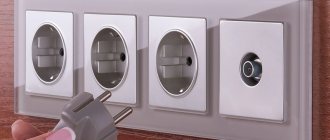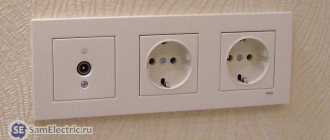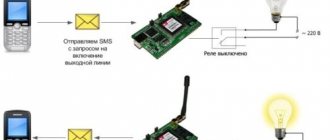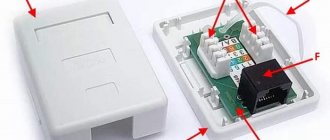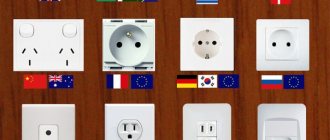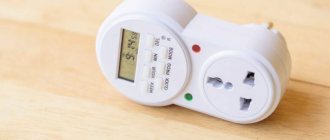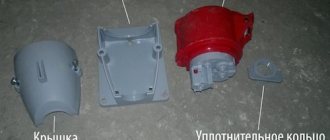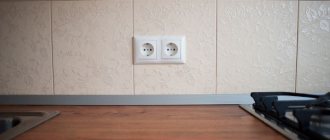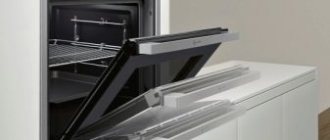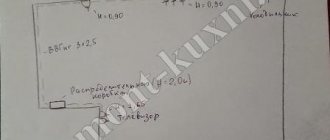Quite a lot of questions from readers come specifically about connecting TV SAT sockets. This is due to the existence of several possible connection methods and wiring diagrams to such sockets and the corresponding differences in mechanisms.
Often, to avoid difficulties when installing a TV/SAT outlet, it is enough to simply choose it correctly. Let's understand everything in order.
The first thing you need to know about any TV sockets , including their modifications, such as tv/sat and tv/fm/sat, is that they come in terminal and pass-through types.
Pass-through TV sockets - as the name suggests, are connected via a cable, i.e. First, the cable from the signal source goes to the first socket, from it to the second, then to the third, etc. The last socket in this circuit is installed. Accordingly, they have two connectors for connecting the antenna cable - input and output.
The terminal TV sockets are connected according to the “star” scheme, when an independent cable is laid from the signal source to each socket.
As you understand, the choice of the type of TV sockets used completely depends on the wiring diagram to them; if it’s a “star”, then the end ones are installed, if the loop is “through” (except for the last one, which, as you remember, is the end one).
When choosing the type of wiring “star” or “loop”, you must first of all be guided by minimizing losses.
Often, in an ordinary apartment, it is better to always use a “star” and install terminal sockets everywhere. In cases where the cable routes from the signal source to the consumer made by a “star” are very long, it is better to use a “loop”, since the losses (attenuation) in this case will be much less than what a long cable will give.
What kind of lighting do you prefer?
Built-in Chandelier
Now, as for TV/sat sockets, in addition to the fact that there are pass-through and terminal sockets , they are also divided into two types:
Sockets without a filter-divider do not separate the signal and two independent coaxial cables are connected to them, one coming from the satellite dish equipment, and the other from the over-the-air antenna.
Therefore, to avoid connection problems, choose the right TV/sat outlet . The actual connection of the television cable to the connectors is no different from installing a regular TV socket. We described this connection in great detail HERE.
You can find out what type a particular TV/SAT outlet model is from the consultants of an electrical store or on the manufacturer’s website.
Perhaps I will keep a small list of specific models of TV/SAT sockets, divided by type, so that it will be easier for you to make a choice in the store, coming with a specific item. If this is really necessary, write in the comments to the article. In addition, if you still encounter difficulties with connection, feel free to write too, I will try to help promptly.
Expert opinion
It-Technology, Electrical power and electronics specialist
Ask questions to the “Specialist for modernization of energy generation systems”
What is the difference between a terminal TV socket and a pass-through socket? The necessary work requires certain knowledge in electrical engineering, but allows you to achieve a reduction in noise and other negative phenomena by 70. Ask, I’m in touch!
Conclusions and useful video on the topic
You can see how to choose and install modern antenna sockets correctly in the following videos.
To install a built-in television socket yourself, you must have the knowledge of an amateur electrician and be able to understand the types of wires and sockets. If you have designed a complex circuit using additional devices, then it is better to contact your provider regarding installation issues - only a specialist will be able to take into account all the nuances of the connection.
If you have any questions while reading the information, there are recommendations to help independent home craftsmen, or you have found shortcomings in the material, please leave comments in the block located under the article.
A television socket is a special device that, depending on the specific type of design, is capable of performing various tasks. In particular, using sockets you can connect a number of devices in parallel, increase the network area, etc.
Types of sockets
Stores of the Leroy Merlin retail chain offer their customers the following types of television sockets:
- Pass-through devices are equipped with an input and two outputs, to one of which you can connect the necessary equipment, and to the other - the next outlet. When laying a network, it is necessary to take into account that each socket leads to the fact that the signal becomes somewhat weaker, and therefore installing too many such devices is impractical. Pass-through models are needed in order to connect several devices at once; in most cases, they are operated in combination with terminal sockets.
- The terminal sockets complete the network and help improve the quality of the television picture, for which the characteristic impedance indicator is at the level of 75 Ohms.
- Individual sockets also complete the network, but do not have the same impressive resistance as their wave counterparts, which can cause picture problems.
Principles of selection and installation
When choosing an outlet, be sure to find out its operating frequency. Likewise, if you plan to connect additional devices to the product in the future, such as a modem, you should choose models with inputs specifically designed for this.
When installing a socket on a wall, it is better to use special boxes that reduce the mechanical load on the element and increase its durability.
Expert opinion
It-Technology, Electrical power and electronics specialist
Ask questions to the “Specialist for modernization of energy generation systems”
TV socket - 95 photos of placement and design features The considered connection diagrams for TV sockets can be combined in some cases, although this is only used when building complex, branched systems; in an ordinary house such a need is unlikely. Ask, I'm in touch!
Types of sockets
Now knowing the connection diagrams, you can consider in more detail the types of TV sockets and their purpose. After all, for each circuit you need to purchase only a certain type of sockets. Purchasing sockets of a different type can significantly reduce signal quality.
Single socket or star socket
The design of a television socket made according to the star topology has the simplest design. Therefore, we will begin our analysis with it.
- This socket has a connector for connecting one power cable. Clamp or screw terminals are available for installation. In some cases, the center conductor has screw terminals and the braided shield has screw terminals.
- The drop in signal level in such sockets does not exceed 1 - 3 dB. This can be achieved due to the fact that the filter for an unmatched or reflected signal is located on the splitter. Due to this, the signal drop occurs only due to switching noise at the connection point.
Pass-through sockets must solve a whole range of problems. They must provide sufficient signal level at a given outlet and minimal signal drop at subsequent outlets. Therefore, their design is much more complicated.
- The feed-through socket has two connectors for a suitable and an outgoing cable. The contact part of the socket can be made with screw, clamp or mixed terminals. Thanks to this, connecting the cable yourself will not be a problem.
- The drop in signal level for such an outlet is the same 1 - 3 dB. But there is some peculiarity here. The fact is that the signal drop on the outgoing cable can be from 10 to 15 dB.
- This is due to the fact that in the pass-through circuit it is necessary to ensure filtering of the reflected signal. For this purpose, a special resistance of capacitive or resistor type is provided in the socket. It reduces noise levels at all outlets in the circuit.
A terminal socket is often confused with a single socket. But structurally they are somewhat different. And it’s not just a matter of installation location.
So:
- The instructions for installing the terminal socket assume its use only in a pass-through circuit as an end point. In this case, the contact part of the socket is visually indistinguishable from the contact part of a single socket.
- The drop in signal level at such an outlet is caused only by transition resistances and amounts to 1 - 3 dB. But here there is the same feature that is characteristic of pass-through sockets.
- A TV connected to such an outlet produces a reflected signal, which in the form of interference or a superimposed image can appear on neighboring TVs in the circuit. In this regard, a filter for inconsistent signals is also provided here. The losses on it are 10 - 15 dB.
Single sockets with two terminals and other types of TV sockets
Separately, I would like to consider single or simple sockets that contain two cable entries. This somewhat puzzles potential buyers and it seems to them that they are being deceived.
- The fact is that many manufacturers produce single sockets for two power cables. The second cable serves as an additional power source.
- Let's say you had an outlet for a TV antenna. But you decided to connect satellite TV. In order not to completely redo the television network, you can simply connect the second cable to the outlet. At the same time, thanks to frequency division, the signals will not cause interference.
- Separately, I would like to note the double TV-R (TV-FM) sockets, as well as the triple TV-R-SAT (TV-FM-SAT). To connect such outlets, one or two cables are used. Due to the different signal frequencies, they separate the signal into television, radio and satellite signals.
- Thus, the TV cable socket transmits signals with a frequency of 5 - 68 and 120 - 862 MHz, the radio output transmits signals with a frequency of 87 - 108 MHz, and the satellite signal arrives in the frequency range 950 - 2400 MHz. Thanks to this, you can unify your TV socket as much as possible.
Nuances of sound insulation
The need to carry out such work makes us think about what materials should be used to achieve the highest quality result. At home, in 55% of cases, people use ordinary polyurethane foam for this purpose. Experts call for abandoning this idea for a number of reasons. Among them:
- the possibility of penetration of foam particles into an adjacent socket through holes (this leads to breakdowns in 50% of cases);
- high probability of fire (the mounting foam is dry; if a spark passes during operation, the material will ignite);
- foam is a low-quality soundproofing material.
Even special polyurethane foam will not be able to withstand heating above 90 degrees. To prevent fire hazards, the use of this material should be avoided.
Which TV outlet to buy
To decide on the type and number of Valena TV sockets that you will need, you need to choose a TV connection diagram. With single options, everything is clear: one device - one TV socket (by the way, it can be not only simple, but also terminal). But the television network in the apartment can be installed in one of two ways:
- Star scheme. Several outlets are connected to one splitter. The circuit requires a large cable consumption, but is characterized by minimal signal attenuation. Here you will need terminal or simple Quteo TV sockets according to the number of TVs to be connected.
- Pass-through circuit, or daisy chain connection. TVs are connected in series. Here you will need one terminal socket for the TV antenna and several pass-through sockets.
Don't worry that with a daisy chain connection, the latest TV will show poorly. The signal level of modern cable television and the thoughtful design of the Kaptika television socket (or another Legrand model) provide all connected screens with a high-quality picture.
The main differences between antenna cables
For high-quality installation and connection, it is not enough to purchase suitable television sockets. Here you cannot do without an antenna coaxial cable, which has a special structure. It consists of:
If any component of the cable fails, the signal will be disrupted. Therefore, when buying a cable, you should check the integrity and strength of the sheath, and during packaging and transportation you should make sure that the cable does not bend, thereby protecting the copper core and screen braid from damage.
For installation under plaster or other finishing materials, cable brands such as SAT 50, RG 6 and RG 11 are suitable.
For an overview of coaxial cables for TV video, see below:
TV socket: types and features of application, socket design
Even special polyurethane foam will not be able to withstand heating above 90 degrees. To prevent fire hazards, the use of this material should be avoided.
Expert opinion
It-Technology, Electrical power and electronics specialist
Ask questions to the “Specialist for modernization of energy generation systems”
TV socket When laying a network, it is necessary to take into account that each socket leads to the signal becoming somewhat weaker, and therefore installing too many such devices is impractical. Ask, I'm in touch!
The mysterious TV RD SAT outlet and its brothers
In addition to regular TV sockets, manufacturers offer products with mysterious names tv rd sat, tv fm sat, tv sat, TV-RD, tv + rj 45. In fact, there is nothing mysterious about them and these are simply combined sockets for connecting 2- 3 different receivers.
It's no secret that providers most often offer packages of terrestrial television, radio, satellite and Internet in addition. If you don’t want to drag a bunch of cables into the apartment, then install a mixer block in the switchboard on the site. It collects signals from several antenna cables into one output cable, and it is brought into the apartment. And in order to then separate the frequencies of different broadcasts, a combined socket is installed to connect a group of receivers.
Such sockets are also useful in houses with cable networks. There, there can be one adder blocks per entrance and one cable is pulled to the consumer at once. To separate different signal frequencies you need a combined socket.
Let's understand the intricacies of names using the example of Legrand products
TV-RD-SAT sockets
TV-RD-SAT sockets can be found in the Valena and Galea Life series. They are designed to connect a television (TV), radio (RD) and satellite receiver (SAT). Suitable for cable networks, they can be either pass-through or terminal.
TV-FM-SAT sockets
TV-FM-SAT sockets are present in the Celiane and Valena series. They are used as single cables in home TV cable installations. They are connected according to the “star” scheme, directly connecting to the splitter along one line. The outlet itself can include a TV and radio receiver, as well as a satellite receiver.
TV + RJ 45 socket Legrand CelianeWhat TV sockets are needed for a satellite dish?
If you have a satellite dish and need to connect TVs to it, then it is most convenient to use combined sockets with 2 inputs TV RD SAT or TV FM SAT. We recommend star wiring with simple sockets. To connect, use the SAT socket.
To summarize, we can say that there are a lot of options for TV sockets, both individually and in assemblies. See what suits you best and don't forget about regular power outlets. They will need to be installed in sufficient quantities, at least 3 pieces each, otherwise it will turn out that there is nothing to power the devices connected to the antennas. And you need to throw an extension cord from another outlet. And we tried so hard to get rid of all the tails from the wires.
How to connect a TV outlet - 3 mistakes. Legrand, Schneider. TV cable connection diagrams.
- Frame. Sometimes it is also called a printed circuit board. It is needed to combine with the antenna cable.
- Front panel. This detail serves more of an aesthetic and protective function. The socket panel for satellite TV can be made in different colors, which makes it possible to blend harmoniously into the overall interior of the rooms.
- Adder. A part with which you can additionally connect a radio and satellite antenna.
- Caliper. This element is needed to firmly fix the entire socket system in the installation box.
Useful tips Connection diagrams Principles of operation of devices Main concepts Meters from Energomer Precautions Incandescent lamps Video instructions for the master Testing with a multimeter
Features of the TV socket
The Legrand TV socket allows you to install several receivers without entangling your apartment with wires. This compact electrical device separates signals of different types and prevents interference in the network. Depending on the number and location of televisions in the house, it is possible to install three types of sockets:
- Single socket for TV. It is also called simple or individual. The device has minimal characteristic impedance, so there may be interference on the screen.
- Pass-through television socket. She becomes a link in the chain. This socket has an input for a cable, an output for connecting a TV, and an output for the next socket. It must be taken into account that with such a connection scheme the signal attenuates.
- TV socket terminal. The characteristic impedance of the device is commensurate with the line resistance, 75 Ohms. Such a socket for a television cable is mounted at the end of the chain, that is, it will be preceded by a pass-through device.
Installation
There are no strict rules for choosing where to install a TV outlet. The only thing you should be guided by is your own aesthetic sense. If you want your house to not look like a spider's lair, place the TV socket closer to the edge of the screen.
The cable laying from the outlet to the antenna can be hidden in a pre-prepared duct for low-current networks or external. The first option is ideal for those who want to forget about the existence of wires in the apartment. But if the repairs have already been carried out and the communications are hidden, the sockets will have to be installed externally, and the cables can be aesthetically hidden behind baseboards and cable ducts.
Different types of sockets are used for hidden and external installation. When choosing a device, ask the seller for the type of installation.
Expert opinion
Viktor Pavlovich Strebizh, lighting and electrical expert
Any questions ask me, I will help!
The advantages of parallel connection are not only good signal quality, which is usually weakened by pass-through sockets. If there is something you don’t understand, write to me!
How to determine the height of the location
As a rule, the TV socket is mounted at approximately the same height as the TV. If the TV is placed directly on the wall, then it is advisable to hide the socket behind it. This also solves the aesthetic issue: connectors and wires will not be visible. Safety measures will also be observed: the socket will not become a subject for children to play with, and pets will not be able to chew the wires. Be sure to watch the video on how to install sockets behind the TV:
It is customary to place such equipment based on the eye level of the person sitting on the chair. On average, this is a height of 130 cm from the floor to the outlet. In some rooms, such as kitchens, this figure is slightly higher, this is due to the fact that the TV is placed in a free space, saving work space.
If you need to buy a television socket, then you should pay attention to high-quality products produced by well-known manufacturers. You should not buy TV and audio sockets at a more attractive, reduced price. Such equipment will not be able to provide a good signal. In addition, in order for the sockets to fit harmoniously into the interior, they must all be from the same collection of a certain manufacturer.
